![]()
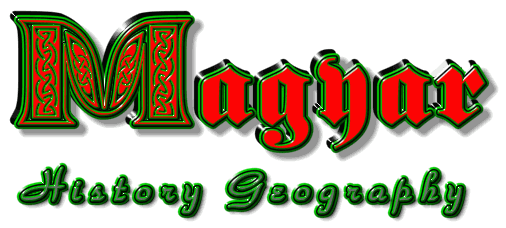
![]()
Home | Introduction | After 1700 A.D.
Concerning the origins of the Hungarians, there are two competing theories. The controversy is still raging. See Fred Hámori's discussion on the Hungarian language and its similarity to Sumerian etc. which is relevant to the discussion. Bear with me, it is not all that boring.
Proponents argue that there is strong evidence that the Hungarian language is closely related to Sumerian, and therefore the Hungarians had been in Europe far longer than previously thought, and that the related people, the Magyars, had joined them later in 895 A.D.
During the 19th c., British, French, and German researchers discovered the most ancient civilization, that of the Sumerians, in Mesopotamia, and deciphered their language, coming to the conclusion that the Sumerians were neither Semitic, nor Indo-European: the Sumerians belonged to the Turanian ethno-linguistic group which includes Hungarian, Turkish and Finnish. Comparative linguistic analysis has shown that the language closest to Sumerian is Hungarian. The evidence therefore suggests that the ancestors of the present-day Hungarians had established themselves in the Carpathian Basin as early as the Neolithic period (late Stone Age), well before the arrival of the Magyars in 895 AD, who represented the last major link in the Scythian-Hun-Avar-Magyar continuity of Turanian peoples which amalgamated with their ethno-linguistic relatives of Near Eastern origin previously settled in the Danubian region.

The advocates of Theory (1) argue that the (Finno-Ugrian) Theory (2) below, attempted to portray the Hungarians as a culturally and racially inferior ethnic group which is alien to Europe. This theory was therefore useful for those regimes which sought to justify the subjugation of the Hungarians and which had territorial claims against them.
In contrast, prior to the introduction of the Finno-Ugrian theory, the Hungarians' own traditional account of their origins and history was that their ancestors were Atilla's Huns. This knowledge was passed on orally from one generation to the next as all the ancient written records of the Hungarians had been destroyed during the forced Christianization of Hungary, a process which was highly detrimental to the original cultural identity of the Hungarians. The Finno-Ugrian theory, which denies the Hun-Magyar ethnic relationship, was therefore designed to weaken the Hungarians' national consciousness and thus to facilitate their domination by external forces. [Dombi]
Hungarian is undeniably related to the Finno-Ugrian language family, but it is also related to the Ural-Altaic languages as well as others. The Finno-Ugrian theory, however, is based entirely on linguistic arguments and therefore cannot agree with or explain traditions, early history, archeology, anthropology, traditional music, art, burial customs or anything else to do with early Hungarians. Things which amongst Hungarians had very early historic roots in the east. [Hámori]
Theory 2: The Finno-Ugrian Theory
The generally accepted story of Hungarian origins is as follows:
About the origins of the Hungarians, the only thing known with certainty is that they are related to the Finns, and their language belongs to the so-called Finno-Ugrian language family, together with that of the Vogul and Ostyak peoples of the northern Urals. With the distant Finns as their only cousins, the Hungarians have no linguistic ties with their neighbours.
At some unknown period of the early Christian era, the ancestors of the Hungarians were driven out of the area around the Ural mountains and migrated south and finally settling between the Don and the Kuban rivers around Levedia on map below, becoming neighbours of the Khazars even before the latter dominated the region. The Khazar Empire is famous for converting to Judaism in order to resist pressure from both Christianity and Islam. The Hungarians became a part of a loose federation of semi-nomadic group, the Onogurs or 'The Ten Arrows' or ten tribes.
The word 'Hungarian' is mistakenly believed to be a Slavonic version of 'Onogur'. It was pointed out to me by Meric Atalay (who is proficient in Old Turkish) that the word 'Hungar' is an old Turkish (turanian) word, 'Hun' = Hun, 'Gar' = 'Gur' = Great.
Hungarians have called themselves 'Magyar' from ancient times.
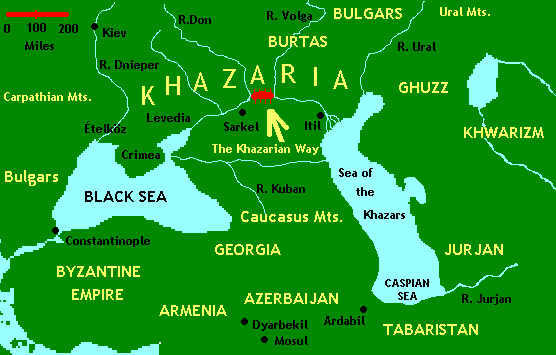
As the Khazars rose to prominence, the Magyars were already subjects of their Empire from the middle of the 7th. to the end of the 9th. centuries. While other tribes were in continual conflict with the Empire, there is no record of a single armed conflict between Khazars and Magyars, even as each was warring with their neighbours such as the Volga Bulgars, Danube Bulgars, Ghuzz Turks, Pechenegs, Arabs and the Rus. The Khazar Empire had stood against the Arab conquests which had threatened Eastern Europe in the 7th. and 8th. centuries. European history would have been very different if the Khazar Empire had not existed. The Khazars affected or shaped much of Western Europe, and in particular the early Magyar nation in two important ways; firstly, they gave the Magyars a king, who was to found the first Magyar dynasty; secondly, several Khazar tribes joined the Magyars which would deeply transform their ethnic character.
Until the Khazars interferred in Magyar affairs, these had no king only tribal chieftains. The most notable was Lebedias, after whom Levedia is named on map above, he was offered the kingship of the Magyars by the Khazar Kagan but declined and said the honour should go to another chieftain called Álmos or Álmos' son, Árpád. Around 850 A.D., Árpád was made 'king' of the Magyars, and he would lead his people in the conquest of Hungary. His dynasty would reign till 1301. The Khazars were responsible for many such historical events. [Koestler]
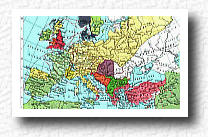 At some time, three Khazar tribes,
called the Kabars or Kavars belonging to the Khazars' own race,
had rebelled against the Empire. They were either slaughtered or
fled to settle with the Magyars. Around 895 A.D., the Magyars'
association with the Khazar Empire came to an end when seven
Magyar tribes and one Kavar tribe crossed the Carpathians and
settled in the land which they would call home for the next 1100
years (purple area of the map on the right). Till the middle of
the 10th. century, both the Magyar and the Khazar languages were
spoken in Hungary.
At some time, three Khazar tribes,
called the Kabars or Kavars belonging to the Khazars' own race,
had rebelled against the Empire. They were either slaughtered or
fled to settle with the Magyars. Around 895 A.D., the Magyars'
association with the Khazar Empire came to an end when seven
Magyar tribes and one Kavar tribe crossed the Carpathians and
settled in the land which they would call home for the next 1100
years (purple area of the map on the right). Till the middle of
the 10th. century, both the Magyar and the Khazar languages were
spoken in Hungary.
There was not a single European princedom, kingdom or country that had not employed these strange and fierce warriors as mercenaries. The Khazar elements within the Magyar ranks were the most restless. Until 955 they carried out raids on and various incursions into the territories of the Holy Roman Empire. After the Emperor, Otto I. defeated them at Lechfeld in 955, Christianity began to permeate the Hungarian leadership, culminating in the acceptance of Catholic Christianity by the Árpád dynasty under Géza in 975.
****
Theory (1) maintains the Magyars had joined their cousins in Hungary in 895 A.D., completing the Scythian-Hun-Avar-Magyar continuity in the Carpathian Basin. The theories merge around here.
****
The conversion of Hungarians to Western Christianity and the founding of their Christian state had dual significance. First of all, it eliminated the remnants of Byzantine Christianity from Central Europe. Secondly, the founding of the Hungarian state separated the two groups of the Slavs, the Western and the Eastern (or Northern and Southern), and thereby helped preserve Western Christianity among the Czechs, Slovaks, Poles, Croats, and Slovenes. Only the Hungarians were able to prevent the complete Germanization of the Slavs in the Danube area. Indeed, the Hungarian state was a bastion of Westernization, and to a great extent it also defended the region against the German expansion more effectively than any other nation in this part of Europe. [Wagner]
Géza's heir, István or Stephen I. (997-1038), the first king of Hungary was wed to Gisela, the daughter of Henry II. of Bavaria and the sister of the Holy Roman Emperor Henry III, in 996. Stephen I, laid down the foundations of medieval Hungary, some elements of which survived even in later centuries. From the point of view of Christian civilization, the most essential principle of Stephen's reign was his unique conviction that a "unilingual country with the same, homogeneous manners and customs is weak and fragile".
This unique principle of nationality policy preferred the multilingual state over the unilingual one and this was in line with the needs of the young Christian state which badly needed more and more foreign-born priests, missionaries, teachers and other learned men to build up a new civilization, new socioeconomic structure, and political system on a Christian foundation. This unique nationality policy was also intended to keep under control the influential Hungarian pagan groups which frequently revolted against foreign-born elements upon seeing the latter in high-ranking positions. Sadly, many pagan records and symbols were systematically destroyed. Pope Silvester II vested Stephen with royal dignity and a crown in 1000.
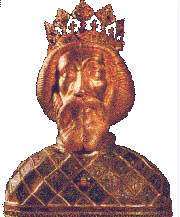 After the civil war ensuing on
Stephen's death, László I. or Ladislas I. (1077-95) restored order and
closely allied Hungary with the imperial throne and the papacy (not
an easy balancing act). In 1083, Ladislas began a "campaign"
of canonization. First, he had two hermits of Polish descent, Andrew and Benedict, elevated to sainthood, then Emeric's
tutor, Bishop
Gerard (Gellért),
who died a martyr's death during one of the pagan uprisings, next
Stephen
I, and finally
Stephen's son Emeric.
After the civil war ensuing on
Stephen's death, László I. or Ladislas I. (1077-95) restored order and
closely allied Hungary with the imperial throne and the papacy (not
an easy balancing act). In 1083, Ladislas began a "campaign"
of canonization. First, he had two hermits of Polish descent, Andrew and Benedict, elevated to sainthood, then Emeric's
tutor, Bishop
Gerard (Gellért),
who died a martyr's death during one of the pagan uprisings, next
Stephen
I, and finally
Stephen's son Emeric.
By this means he also certified his nation's and his family's integral presence in Christian Europe, meanwhile issuing a warning to the remaining followers of pagan rite. And though his character, like Stephen's, hardly met every requirement of sainthood in the mirror of undistorted sources, legends were quickly woven around him as well. Ladislas, the creator of saints, was not the only one who later gained for himself the glory he obtained for others. His daughter, who became empress of Byzantium -Piroska was her Hungarian and Irene her Greek name- was to become a saint of the Eastern Church. [Lázár] Ladislas I. was canonized in 1192. His line continued close relations with the major European powers.
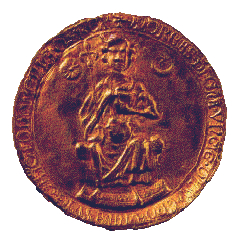 Béla III. (1172-96) married a Capetian
princess, Agnes Chatillon (part of a French attempt to woo
Hungary from the imperial sphere of influence). His father-in-law
was the king of France himself.
Béla III. (1172-96) married a Capetian
princess, Agnes Chatillon (part of a French attempt to woo
Hungary from the imperial sphere of influence). His father-in-law
was the king of France himself.
Andrew II. (1205-35) joined the rest of Europe on crusade in 1217, as a result of which in 1222 he was presented with a baronial revolt not unlike that experienced by John in England. Like John, he was forced to grant the Hungarian "Magna Carta" of baronial rights called the "Golden Bull" in 1222 - the English "Magna Carta" was signed on June 12, 1215. (In Latin 'bula' means a 'seal', hence the 'Golden Seal or Bull'.) Under this decree, in return for the right of taxation, the king granted special rights to all noblemen--defined as families of Magyar blood (and excluding serfs). These included the right to hold office, exemption from taxes, and the right to petition for grievances. From the right to petition grew a representative Diet or parliament. When the royal house died out in 1301, the nobles gained the right to select (elect) their king: to secure election, monarchs had to reconfirm the rights of the noble class. [Sowards]
When Andrew died in 1235, his son Béla IV. (1235-1270) - almost the only man in his country who took the danger the Mongols posed at its full value - had organised a system of defences on the passes and had tried to collect an army inside Hungary. When the Mongols moved again, in the spring of 1241, they easily overran the frontier posts, and on 11 April outmanoeuvered the Hungarian army which met them at Mohi, on the Sajó river, and almost destroyed it.
Béla himself barely escaped with his life to the Austrian frontier, where Frederick of Austria could find nothing better to do than to blackmail him for an indemnity, extort three counties from him as security for the payment of it, and even invade them himself. The Mongols ravaged central Hungary at their leisure all summer and autumn, then, the Danube having frozen hard, crossed it on Christmas Day and spread destruction in the Dunántúl, while Béla, pursued by their light cavalry, fled ingloriously enough to an island off the Dalmatian coast. [Macartney]
Hungary was saved from complete destruction only by the death of the Great Khan Ogotai in far-away Karakorum. Batu Khan, commander of the Mongol armies in the west, led them back to take part in the contest for the succession, and in March 1242 the Mongols left Hungary as suddenly as they had entered it just a year before. Béla IV., the last man of genius whom the Árpáds produced, is best known as the regenerator of the realm after the cataclysm of 1241-1242.
On his return from exile, after the subsidence of the Mongol deluge, Béla found his kingdom in ashes; and his two great remedies, wholesale immigration and castle-building only sowed the seeds of fresh disasters. Ten years later, the threat posed by the Mongols was still uppermost in the king's mind in the letter he wrote to Pope Innocent IV dated 11 November 1252. He writes with bitterness how Hungary was left to fend for herself.
All of Europe had failed his country by refusing to provide any assistance. He wrote "The Tartars were still cutting throats in our country when already we addressed ourselves to the three great powers of the Christian world: To the Holy See, master and teacher of all Christendom; To the Imperial Court to which we have even offered our submission provided that it lent us timely and decisive aid against the Mongol pest; And also to the Royal House of France, but from nowhere did we get aid or comfort, only words." The Knights of St. John of Jerusalem were the only ones who helped in fighting the Mongols.
Stephen V. (1270-1272) contracted an alliance with the powerful Neapolitan Angevins who had the ear of the pope to keep the disintegrating influences at home under control. In 1301 Andrew III. (1290-1301) died and with him the line of the Árpád dynasty became extinct.
Not long after, the papal-supported candidate, the capable Charles Robert of Anjou, a scion of the Angevin line in Naples, became Charles I. of Hungary, ruling from 1308 to 1342. One of the chief props of his power was the wealth which he derived from the gold mines of Transylvania and northern Hungary, the production of which he stimulated by a number of sensible devices. Eventually it reached the remarkable figure of 3,000 lb. of gold annually - one third of the total production of the world as then known, and five times as much as that of any other European state. [Macartney] The wealth of Hungary became the primary support of Angevin dominance in southern Italy.
In 1381, the Byzantine emperor finding the Papacy unable to rouse the West to his aid, agreed to pay tribute to the Turks who had already occupied Gallipoli in 1354. The emperor also had allowed them to occupy Thessalonica. On June 15th., 1389 at least six nationalities led by Serbian Prince Lazar faced the Ottoman Turks at Kosova. The defenders, made up of Serbs, Poles, Hungarians, Bulgars, Rumanians and Albanians were outnumbered 2:1. They were soundly defeated by the Turks. Bosnia, Serbia, Wallachia, Albania and much of that region fell under Turkish rule.
King Charles' granddaughter, Mary, married Sigismund younger son of the Emperor Charles IV and himself Marquis of Brandenburg in 1387. Sigismund ruled with her until her death in 1395 and alone until 1437. He was, simultaneously, Holy Roman Emperor (1410) and King of Bohemia (1420). In 1396 Sigismund, then only King of Hungary and his Crusaders were defeated at Nicopolis by the Turks. Sigismund's son, Albert (1437-1439) of Austria, succeeded him, but died shortly thereafter.
Amurath II, the Turkish Sultan retook Thessalonica in 1430. In 1442 two Turkish armies were beaten off Belgrade. In 1443 King Ladislas of Poland and Hungary, under the brilliant generalship of János (John) Hunyadi defeated the Turks at Nissa and recovered Serbia, Bosnia and Wallachia by the treaty of Szegedin (1444). Hunyadi earned the name of "Törökverö" (Scourge of the Turks) for his efforts.
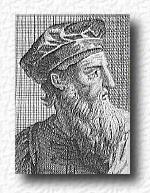 In 1444, repudiating their treaty
the allies attacked Amurath who destroyed them at Varna, Ladislas
and Card. Hunyadi escaped the disaster. The Turks thus recaptured
all the Balkans at one blow (save for Albania which was defended by the magical
successes of George Castriot Scanderberg, a reconverted janissary who fought
the armies of Amurath from 1445-1447).
In 1444, repudiating their treaty
the allies attacked Amurath who destroyed them at Varna, Ladislas
and Card. Hunyadi escaped the disaster. The Turks thus recaptured
all the Balkans at one blow (save for Albania which was defended by the magical
successes of George Castriot Scanderberg, a reconverted janissary who fought
the armies of Amurath from 1445-1447).
On May 29, 1453 the Turks under the young Sultan Mehmet II conquered Constantinople. The great Delphic tripod which had been dedicated after the victory of Greece over Persis at Platća (439 B.C.) and was one of the most splendid treasures of the city, was captured and solemnly struck by Mehmet. Asia was avenged. His rich and powerful Moslem empire seemed poised as a threat to Europe. Pope Calixtus III, who called Hungary the "Shield of Christianity" used all his resources to help Hunyadi raise an army to successfully defend Nándorfehérvár (Belgrade) in 1456. After this, there was a high expectation that Europe might turn the tide against the Turkish threat with Hunyadi's victories. But it was not to be, as Hunyadi died on August 11, 1456 probably as a result of the plague endemic in Belgrade at that time. The ringing of church bells at midday across Europe commemorate his victories against the Turks.
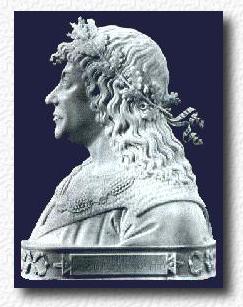 After Ladislas' death, Hunyadi's son,
Mátyás (or Matthias) Corvinus (1458-1490), was placed on the
throne by a magnate-led rebellion. Corvus is the Latin name for Raven which was emblazoned on his fathers's
shield, hence the medieval name of Corvinus. Cultural life
flourished in his palaces at Buda and Visegrád. The word 'Renaissance'
is to be taken exactly, for especially after Mátyás had married,
as his second wife, Beatrix of Aragon, daughter of the King of Naples,
the influences of the early Italian Renaissance dominated his
court. For a few decades, Hungary lived on par with Western
European standards. Corvinus succeeded in 1469 in making himself
master of Moravia, Silesia and Lusatia, with the title of King of
Bohemia. He prosecuted war against the empire, seizing and ruling
until his death lower Austria, and Styria.
After Ladislas' death, Hunyadi's son,
Mátyás (or Matthias) Corvinus (1458-1490), was placed on the
throne by a magnate-led rebellion. Corvus is the Latin name for Raven which was emblazoned on his fathers's
shield, hence the medieval name of Corvinus. Cultural life
flourished in his palaces at Buda and Visegrád. The word 'Renaissance'
is to be taken exactly, for especially after Mátyás had married,
as his second wife, Beatrix of Aragon, daughter of the King of Naples,
the influences of the early Italian Renaissance dominated his
court. For a few decades, Hungary lived on par with Western
European standards. Corvinus succeeded in 1469 in making himself
master of Moravia, Silesia and Lusatia, with the title of King of
Bohemia. He prosecuted war against the empire, seizing and ruling
until his death lower Austria, and Styria.
It was nearly seventy years after János Hunyadi's death before the Ottoman Turks moved against Europe once again. To counter this threat, Pope Leo X had granted a Crusade specifically against them. However, by the early 16th century, the Turkish long advance had already caused considerable unrest. The many demands of this new crusade plus fears that this crusade would put them in even more danger, caused some 40,000 farmers from all over Hungary to join in the Peasants' Rebellion of 1514.
They overthrew Pest (the other half of Budapest), burning, murdering and plundering and could not be stopped. Even ecclesiastical bans had no effect as the rebels no longer obeyed their own leaders. Eventually, the king's forces managed to capture some of the ringleaders, which seemed to take the wind out of the sails of the rest. Some however fled to the Bácska (in German: Batschka) in Bács-Bodrog county for safety and continued the struggle there, burning the churches of the nobility. János Szápolyai, the voivode (governor) of Transylvania - he was already a most powerful noble at the time of king Mátyás (Matthias), and a major figure among the lesser nobility - was the military leader who ruthlessly and cruelly suppressed the peasant revolt. (Later, Szápolyai would vie with the Hapsburgs for the Hungarian Crown.)
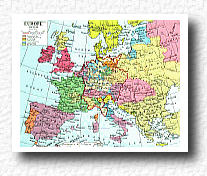 By 1519, Wallachia (before it became
Rumania), Bosnia, Serbia, Moldavia and Bulgaria were part of the
Ottoman Empire. As immediate neighbours, the Turks saw that all
of this conflict left Hungary in a dangerously weak state,
divided and ill-organized. The Ottoman Turks were all too happy
to take advantage.
By 1519, Wallachia (before it became
Rumania), Bosnia, Serbia, Moldavia and Bulgaria were part of the
Ottoman Empire. As immediate neighbours, the Turks saw that all
of this conflict left Hungary in a dangerously weak state,
divided and ill-organized. The Ottoman Turks were all too happy
to take advantage.
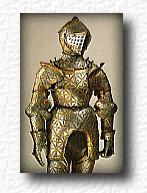 Their Sultan, Süleyman I (the Magnificent) was to bring his
empire to its greatest historical extent. In 1526, Hungary's army,
outnumbered 3:1, was defeated at Mohács (southern blue frontier of modern
Hungary on the map below), the young and yet childless Hungarian King Louis II being lost in the battle. Click on
his armour on right - in the Hungarian National Museum. The archbishops of Kalocsa and
Esztergom, five bishops, enormous numbers of nobles, and some ten
thousand soldiers were killed.
Their Sultan, Süleyman I (the Magnificent) was to bring his
empire to its greatest historical extent. In 1526, Hungary's army,
outnumbered 3:1, was defeated at Mohács (southern blue frontier of modern
Hungary on the map below), the young and yet childless Hungarian King Louis II being lost in the battle. Click on
his armour on right - in the Hungarian National Museum. The archbishops of Kalocsa and
Esztergom, five bishops, enormous numbers of nobles, and some ten
thousand soldiers were killed.
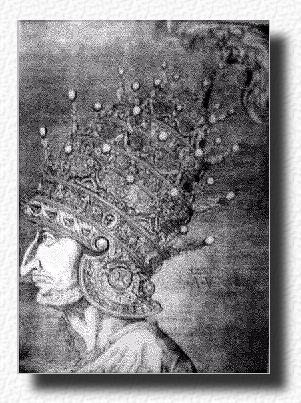 The disaster was made worse by the
death of the King which resulted in two claimants to the
Hungarian Crown, Ferdinand of Hapsburg and the Hungarian János (John I.) Szápolyai. This split the country in its
gravest hour as each claimant had his supporters. Ferdinand was
the brother-in-law of the slain Louis. Neither could best the
other, so Szápolyai appealed to the Sultan for aid in order to
limit the Hapsburg's power in the western and northern part of
Hungary (Croatia and Slovakia). For a time Hungary had two kings
because each had secretly agreed that Ferdinand would inherit the
lot if the older Szápolyai died first. However, Szápolyai's
wife bore him a son just before he died. The Sultan not only
recognised the infant as rightful heir and king, but also as his
Vassal. The Sultan acted quickly and moved to occupy central and
southern Hungary.
The disaster was made worse by the
death of the King which resulted in two claimants to the
Hungarian Crown, Ferdinand of Hapsburg and the Hungarian János (John I.) Szápolyai. This split the country in its
gravest hour as each claimant had his supporters. Ferdinand was
the brother-in-law of the slain Louis. Neither could best the
other, so Szápolyai appealed to the Sultan for aid in order to
limit the Hapsburg's power in the western and northern part of
Hungary (Croatia and Slovakia). For a time Hungary had two kings
because each had secretly agreed that Ferdinand would inherit the
lot if the older Szápolyai died first. However, Szápolyai's
wife bore him a son just before he died. The Sultan not only
recognised the infant as rightful heir and king, but also as his
Vassal. The Sultan acted quickly and moved to occupy central and
southern Hungary.
In the spring of 1541, Ferdinand's general Roggendorf, laid siege to the capital of Hungary, Buda. As soon as the Turks approached as well, the Austrians panicked and tried to flee while the Turks cut them to pieces. The Turks then proceeded to occupy Buda and Hungary was partitioned into three parts. Ferdinand had to conclude a treaty and pay tribute to the Sultan in order to retain his holdings in the north and west, because Francis I of France had made an alliance with the Sultan against the Hapsburgs.
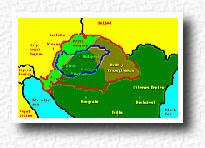 The north-western part of the country known as Royal
Hungary was governed by the Hapsburgs, the central area was ruled by the Turks, and the
south-east Transylvanian principality (today
part of Rumania). In 1566 the Sultan declared Transylvania an autonomous principality under
his own suzerainty. The population suffered the most in central
and southern Hungary which was laid waste and largely deserted as
a result of the slave trade. The land not directly under the
control of the Ottoman government reverted to forest and swamp.
In the north (today's Slovakia) the population enjoyed relative
safety under Hapsburg protection, while Transylvania for a long
time was the citadel of Hungarian culture. Click on the small map
above for a larger view.
The north-western part of the country known as Royal
Hungary was governed by the Hapsburgs, the central area was ruled by the Turks, and the
south-east Transylvanian principality (today
part of Rumania). In 1566 the Sultan declared Transylvania an autonomous principality under
his own suzerainty. The population suffered the most in central
and southern Hungary which was laid waste and largely deserted as
a result of the slave trade. The land not directly under the
control of the Ottoman government reverted to forest and swamp.
In the north (today's Slovakia) the population enjoyed relative
safety under Hapsburg protection, while Transylvania for a long
time was the citadel of Hungarian culture. Click on the small map
above for a larger view.
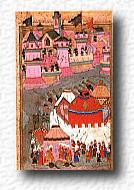 During the years 1669-1673, the
Turks had conquered most of Poland. In 1683, the Turks marched on
Vienna. As Turkish vassals, Hungarians had formed part of this
force. The panic this movement had caused very nearly gave the
attackers the city. Vienna was eventually relieved by
reinforcements led by the Polish general, John Sobiesky. Austria, Poland and
the Republic of Venice
joined forces and attacked the whole European front of the
Turkish positions in 1684. Hungary's capital Buda which had been
in Turkish hands for over a century and a half, was recaptured in
1686. The following year, the second battle of Mohács was fought in which the early
defeat of the Christians was amply avenged. The Turks were
completely routed.
During the years 1669-1673, the
Turks had conquered most of Poland. In 1683, the Turks marched on
Vienna. As Turkish vassals, Hungarians had formed part of this
force. The panic this movement had caused very nearly gave the
attackers the city. Vienna was eventually relieved by
reinforcements led by the Polish general, John Sobiesky. Austria, Poland and
the Republic of Venice
joined forces and attacked the whole European front of the
Turkish positions in 1684. Hungary's capital Buda which had been
in Turkish hands for over a century and a half, was recaptured in
1686. The following year, the second battle of Mohács was fought in which the early
defeat of the Christians was amply avenged. The Turks were
completely routed.
The Peace of Carlowitz in 1699 confirmed the victories against the Turks, giving Hungary and the suzerainty of Transylvania to Austria, Podolia to Poland, the Morea to Venice, and Azov, its first seaport, to Russia.
Home | Introduction | After 1700 A.D.
![]()
Last updated 30 January 2000
Maintainer T. Majlath
![]()